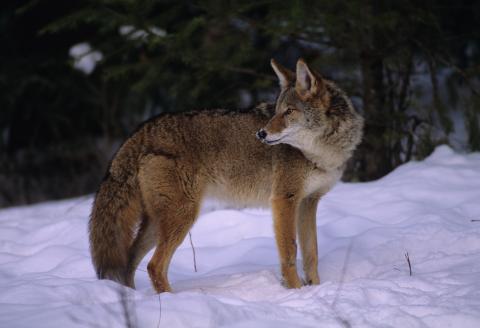Scientific name: Canis latrans
Coyotes are in the dog family, along with wolves and foxes. They have pointed ears, very narrow snouts, and a drooping, bushy tail, often with a black tip. Their fur is generally grayish-brown, but can vary into more reddish or darker hues. They are slender in build, but look bigger and more robust during winter when they have their thick winter coat of fur. They generally weigh between 25-35lbs, with some larger individuals weighing between 40-50 lbs.
Coyotes are monogamous breeders, and mated pairs tend to stay together on territories until one or both die. Breeding occurs during the winter season, and pups are born in April and May. Pups will stay in a den for about three weeks, and remain under close watch of one or both parents for several months. Coyotes stay together as a family unit until offspring disperse to establish territories of their own. Sometimes this dispersal happens during their first fall, at around 6 months of age, but sometimes they stay with their parents for up to two years and will help care for subsequent litters.
The coyote is a territorial animal, and mated pairs will establish a space of their own and defend it from other individuals. Solitary coyotes that are not able to establish territories are known as transients and will often cover great distances finding resources and avoiding defensive, territorial coyotes. Transients may be juveniles, subadults, or adults that have lost their mate and territory, and transient coyotes often have low survival rates because of their heightened movement. These transient individuals are important when considering management of coyotes. Hunters and nuisance trappers often notice that they remove coyotes from an area just for them to reappear shortly after - those are often transients that have found a newly-vacated territory due to the removed individuals.
Coyotes can be active at all times of the day. Especially in urban spaces or areas with a strong human presence, coyotes will do most of their hunting during the night. However, it is not at all unusual to encounter a coyote hunting, moving from one place to another, or patrolling their territory during the daylight hours. Because coyotes are so adaptive, they can shift the timing of important daily behaviors to both avoid threats (like people or harsh weather) and seek opportunities (like the daily behavior patterns of their prey).

